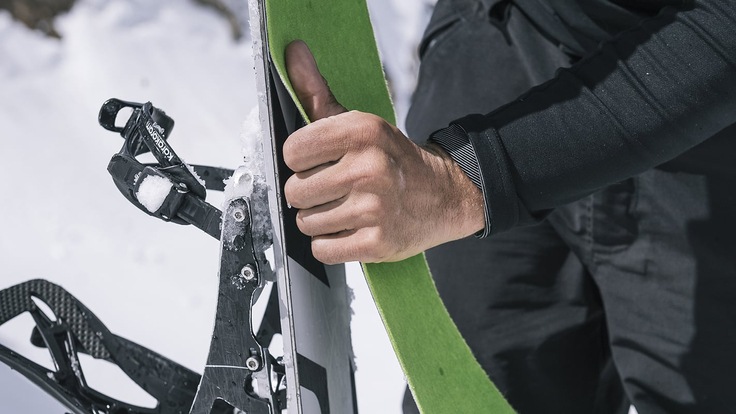Splitboard climbing skins are strips of fabric that attach to the bottom of your backcountry splitboard to allow you to climb up hills with the "skis" on your feet. Most skins attach to splitboards with tip loops, tail clips and sticky glue. Once you reach the top of the hill, peel the skins off, fold them in half, stuff them in your bag, put your board back together and enjoy the ride down.
There are several factors to consider when choosing climbing skins, such as material, length and width. It's also important to understand how to trim skins to precisely fit the width and length of your splitboard and how to attach the skins to your board. (Splitboard skins differ from ski skins; be sure you're buying skins that are specific to splitboards.)
Climbing Skin Material
In the old days, climbing skins were made from sealskin (hence the name). Today, skins are made from nylon, mohair (hair from Angora goats) or a blend of the two. The difference in skin material plays a significant role in traction, glide, durability and cost.
Synthetic skins are typically made of nylon. Nylon is very durable and provides superb traction, but tends to not glide as well as mohair. Nylon skins are usually less expensive than mohair or mohair-blend skins.
Mohair skins provide a good mix of grip and glide and are lightweight, but are less durable and more expensive than nylon.
Blend skins combine nylon and mohair together. They provide a good compromise of grip, glide, weight, durability and cost.
Consider your use when choosing materials. If you're a regular backcountry snowboarder who sets out on long-distance tours, go with skins that are lightweight and offer better glide. If you only occasionally backcountry snowboard or are new to the sport, save some money and choose nylon skins for their durability and excellent grip.
Climbing Skin Length
You'll typically size your climbing skins based off of the length of your splitboard.
Climbing skins are sometimes sold in several different length ranges with pre-installed tail attachment systems that let you fine-tune the fit to the length of your board.
For example, a pair of climbing skins may be sold in three lengths: 147-161cm, 159-175cm, and 172-186cm. If your board is 164cm long, you would buy the 159-175cm skins and use the tail attachment system to fine-tune the length to fit. Tail attachment systems on these skins generally allow for about 10cm of adjustment.
Some skins are sold in a single length that you will trim to fit the length of your board with the included tool. These skins sometimes include a tail attachment system that you'll install after trimming the skins, however, some do not and rely only on the tip loops and glue to attach to your board.
Climbing Skin Width
After choosing the length, it's time to consider width.
Most makers of splitboard skins offer only a single width (usually about 140mm), so this decision is pretty simple. The width of the skin can be trimmed to fit the shape of your board with the included tool.
If multiple widths are available, keep in mind that wider skins cover more of your splitboard base, which results in better traction.
How to Trim and Attach Climbing Skins
Most climbing skins for splitboards are sold as long, semi-rectangular strips with tip loops and tail attachment systems. You'll need to trim the width (and sometimes the length) of the skins so that they match the shape of your splitboard while leaving the metal edges exposed. Leaving the metal edges exposed provides grip when you're traversing hardpack snow and ice.
There are specific guidelines for how to trim and attach climbing skins depending on the brand. Here are three of the most common brands you'll find at REI:
How to Trim and Attach Voile Splitboard Skins
How to Trim and Attach Jones Splitboard Skins
How to Trim and Attach G3 Splitboard Skins
Pre-Cut Climbing Skins
Some manufacturers make climbing skins that are pre-cut to fit specific splitboards. This takes the hassle out of trimming your skins, but you'll likely pay more. Pre-cut skins are generally labeled for a specific board and sold in widths and lengths that match different sizes of that board.
Remember: Safety is your responsibility. No internet article or video can replace proper instruction and experience—this article is intended solely as supplemental information. Be sure you're practiced in proper techniques and safety requirements before you engage in any outdoors activity.
